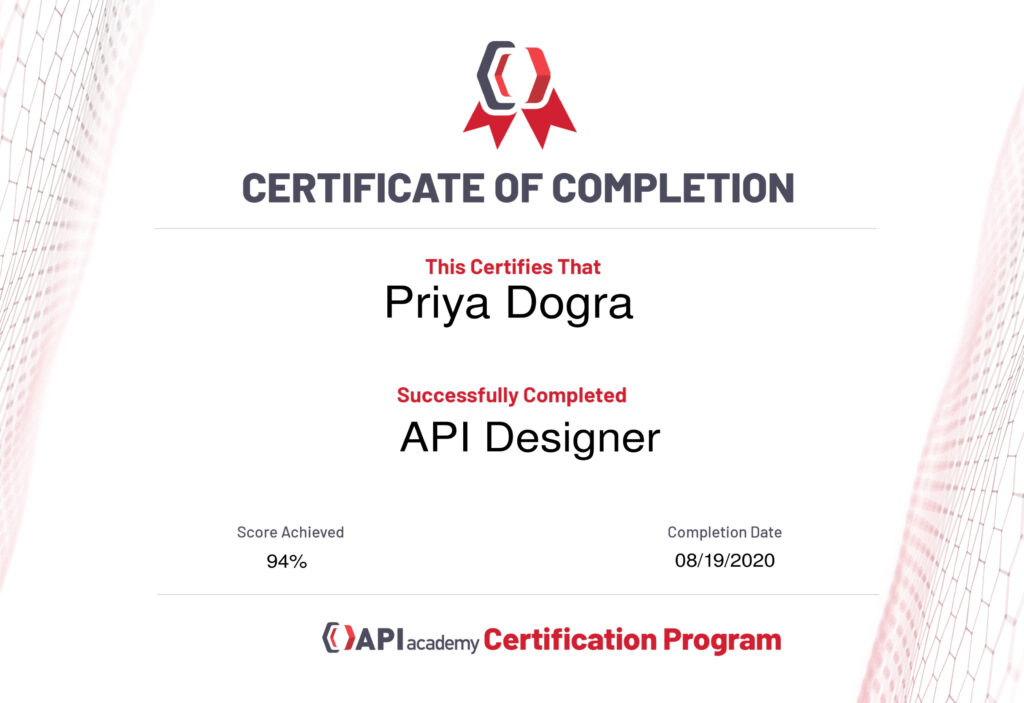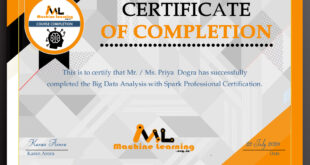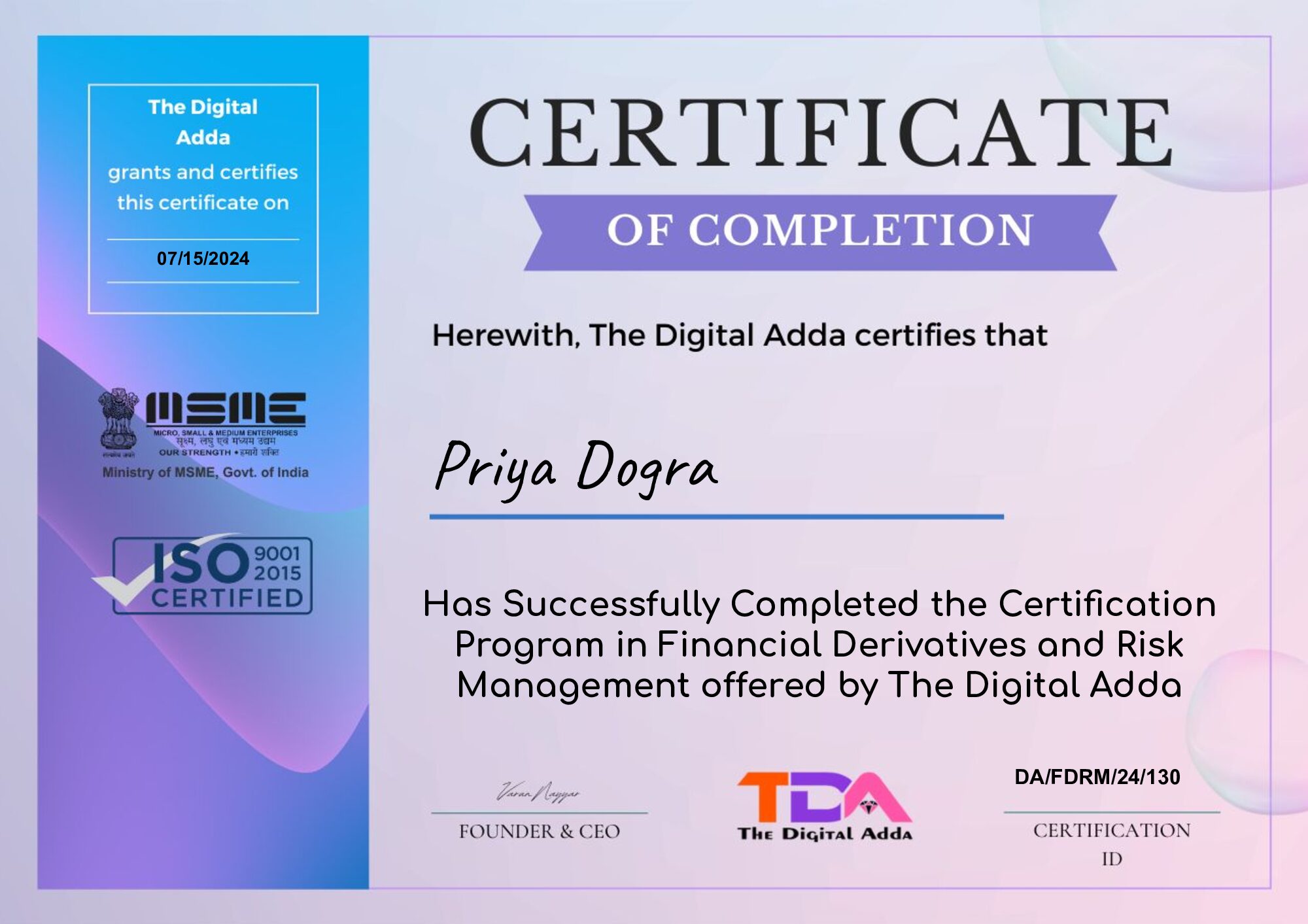Get Certificate : API Designer Certification Exam Answers – API Academy

Question 1: What are some common user characteristics that may be useful when driving the developer experience? (Select all that apply)
- The industry they operate in.
- The size of their organization – whether startup or enterprise.
- Their level of familiarity with APIs and API architecture.
- Their dietary preference.
- The platform they are using or creating applications for.
Question 2: Addressing this challenge early on in the process can help define early adoption, future success, and the lifespan of the API. It can be managed through a combination of load testing, authentication, throttling, quota management, and API caching. What challenge in API design are we talking about?
- Scalability
- Security
- Cost
Question 3: Evaluate the following statement. The new revenue potential is the biggest benefit that APIs can offer to organizations looking to grow their business.
- True
- False
Question 4: In the semantic versioning approach, the following is true:
- The Revision number is relevant the most to the Test Team.
- The Major release number is relevant the most to the Test Team.
- All options are correct.
- The Minor release number is relevant the most to the Build Team
Question 5: The key areas of the API360 model are: (select all that apply)
- Feedback & Analysis
- Scalability & Evolvability
- Readiness & Identification
- Alignment & Usefulness
- Manageability & Security
- Engagement & Usability
Question 6: By offering frequent updates to your API to address security vulnerabilities to protect your end users, and by being completely transparent about the updates in your communication to your third-party developers, you are establishing and building
- Change Management
- High Functionality
- Trust
- Market Engagement
Question 7: Shortly after the launch of your organization’s first API, developers are complaining that they don’t understand what your API does or enables. Which of the following are potential solutions to this problem? (Select all that apply)
- Provide a platform on which the developer can start reading about what APIs are available and what can be done with them.
- None of the options are correct. Your APIs should be self-explanatory to the right users or developers.
- Provide use cases that demonstrate the business practicality of your API.
- Provide a playground explorer environment.
Question 8: Match the following statements with some essential DX considerations.
- Trust -> “The way you communicate to your developer audience is crucial to how they perceive you and your product.”
- Visibility -> “It is important that developers are able to see how their user base is interacting with their application in relation to the APIs.”
- Education -> “Make it simple for developers to create powerful applications, fast, for example by providing comprehensive, easy-to-use documentation.”
- Change Management -> “Provide a clear release history, to easily track new and deprecated features and bugs, no matter which version a user is running.”
- Troubleshooting -> “Developer tool is only as good as the functionality it delivers. Are we providing clear error messages? Are we tracking defects and fixing them?”
Question 9: When we talk about Scalability and Evolvability and enterprise architecture considerations, enterprise architecture should NOT:
- Care exclusively about technology.
- Synthesize multiple perspectives from API stakeholders.
- Anticipate future changes to the business.
- All options are correct.
Question 10: Match the API benefits with the correct statement:
- Outsourced Innovation -> Publishing a public API can lead to unanticipated innovation from third party developers.
- Reach and Retention -> APIs allow content and service providers to reach captive audiences where they spend their time.
- Mobile and Omnichannel -> Offering services through APIs is the best way to provide consistent digital experiences across all channels.
- Interaction Analysis -> A lot of value in APIs comes from understanding your customers better through their use of your APIs.
Question 11: What belongs among the common techniques of “extending the interface” in relation to making changes to your APIs? (select all that apply)
- Make all new changes to the API mandatory
- Never change the meaning of existing things in your API
- Make all new changes to the API optional
- Never take anything away from the functionality of your existing API
Question 12: Match the common challenges in API design with the correct statement.
- Infrastructure Cost -> The wrong approach can lead to unnecessary and unwieldy expenses.
- Scalability -> Addressing this challenge early on in the process can help define early adoption, future success, and the lifespan of the API.
- Security -> Addressing this challenge helps you control the access of legitimate API consumers and protect endpoints against malicious traffic.
Question 13: Which of the following questions DOES NOT apply when considering the API360 model’s ‘Engagement and Usability’ component of your API program?
- Who are the developers who will attract clients to my APIs?
- How do I attract and retain the right consumers and developers?
- What factors will affect the runtime scalability of my APIs?
- Who are the intended and expected consumers of my APIs?
Question 14: Match the following layers of a well-designed API server architecture with the correct statement.
- Caching layer -> Provides optimized response handling to offload backend application processing.
- Representation layer -> Provides a consumer-centric view of the data or service that an API is exposing.
- Orchestration layer -> Aggregates and composes data from multiple backend sources.
Question 15: Match the API styles with the API examples.
- Tunnel Style -> SOAP
- URL Style -> CRUD
- Hypermedia Style -> REST
- Event-Driven Style -> WebSockets
Question 16: Evaluate the following statement. When you make breaking changes to your API, treat it like a new API.
- False
- True
Question 17: Evaluate the following statement. API-related threats, privacy protection, API usage metrics, and access control are all important issues to the Manageability and Security component of the API360 model and can be readily addressed by technology such as an API Management platform.
- False
- True
Question 18: Depending on requirements, a well-designed API server architecture might contain these layers: (select all that apply)
- Securtiy
- Caching
- Basic
- Advanced
- Representation
- Orchestration
Question 19: Evaluate the following statement. Standards bodies (companies such as IETF, W3C, or OASIS) are creating API and protocol specifications and defining internet standards.
- True
- False
Question 20: Match the statements with correct answers:
- How do I add a new mandatory input parameter to requests without breaking existing clients? -> You can use default values to support existing clients.
- How do I add new properties to responses without breaking existing clients? ->Make sure that your clients ignore properties or objects that they don’t understand.
- What if I’m forced to change the meaning of something? -> Add a new property or object and don’t change the existing one.
Question 21: Evaluate the following statement. Ultimately, improving an API’s usability will result in higher adoption rates and lower integration costs – both of which are important goals for any API program.
- False
- True
Question 22: “Be conservative in what you do, be liberal in what you accept from others”, is a rule coined by an early pioneer of the Internet, otherwise known as Postel’s law. In a networking context, it is paraphrased as:
- “Be conservative in what you send, be liberal in what you accept”
- “Deal with unexpected elements by always being conservative”
- “Always be liberal with your requests and responses”
- “Be liberal in what you send, be conservative in what you accept”
Question 23: Organizations like Netflix, HBC Digital, and SoundCloud are all prime examples of how adopting an ‘API First’ engineering philosophy can help companies achieve organizational agility, thereby maximizing
- System Stability
- Scalability
- All options are correct
- Delivery Speed
Question 24: Which of these statements are correct when describing the perspective obstacle of API design? (select all that apply)
- Designers may lack time, budget, and/or skills.
- A well-designed interface should protect the end user from the details of the underlying systems.
- A designer’s internal perspective and specialized knowledge could leak out into design in a way that makes little sense or add no value to an external developer.
- Many organizations segregate the decision makers and users from the designers and teams tasked with implementation and testing.
- Technical purity shouldn’t always win.
Question 25: Name the steps of a basic API design approach in correct order
- Determine goals
- Identify users
- Design Interface
- Evaluate
- Implement
Question 26: Which of these is NOT a characteristic of SOAP?
- Uses a WSDL file to describe its interface
- Uses a WADL file to describe its interface
- Uses HTTP as a transport protocol
- Uses an XML-centric message format
Question 27: Which of these is considered a limitation of the URI/CRUD API style?
- This API style is limited to existing HTTP operations.
- This API style uses hyperlinks and requires the client to understand the relations between hyperlinks.
- This API style has stack dependency that would often tie you into a particular tool chain.
Question 28: Evaluate the following statement. The obstacles in API design that designers might face are: Designers project their own perspective. Designers have biases. Designers make assumptions. Designers lack resources.
- True
- False
Question 29: With the customer data they were able to collect from their API program, Disney was able to continuously build a better experience for their customers. Which of the following API business benefits help drive this type of ‘data-driven insight’?
- Mobile and Omnichannel
- Self-Service Integration
- New Revenue
- Interaction Analysis
Question 30: Fill in the blank. __________ is a software interface, a building block that works behind the scenes to connect different applications and systems so they can share information.
- CRUD
- REST
- DX
- API
Question 31: Evaluate the following statement. “API design” or “API architecture” refers to the process of developing a software interface that exposes backend data and application functionality for use in new applications.
- True
- False
Question 32: A key benefit of this API style is that the media types can be selected to suit the needs of API consumers. There is also a growing body of guidance in helping design effective self-describing APIs that rarely require versioning. When designed correctly, this API style can evolve over many years and continue to support applications that have been developed during its infancy. Which API style are we describing?
- URI/CRUD API
- Tunnel/SOAP API
- Hypermedia/REST API
- Event-driven/Reactive API
Question 33: Match the recommended key deliverables with the key areas of the API360 model.
- Alignment & Usefulness -> API Roadmap and Project Cross Reference. Organizational Model. API Business Models and Business Cases.
- Engagement & Usability -> Developer Program. API and DX Design Principles. API Consumer Toolkits.
- Scalability & Evolvability -> API Architecture Guidelines. Full API Lifecycle Methodology. Technology Roadmaps.
Question 34: Evaluate the following statement. According to the Vitruvian Principles, a good design has to be “solid, useful, and beautiful”. Translated into modern design terms, we could say that these become the principles of “functionality”, “usability”, and “experience”.
- False
- True
Question 35: Match the following qualities of a well-designed API with their description.
- Security -> The API is protected against attack and misuse.
- Usability -> The API is easy for developers to effectively leverage.
- Scalability -> The API is able to handle rapid spikes in traffic.
- Testability -> The API is designed to help developers experiment with functionality.
- Reliability -> The API is robust enough to minimize downtime.
 Priya Dogra – Certification | Jobs | Internships
Priya Dogra – Certification | Jobs | Internships


